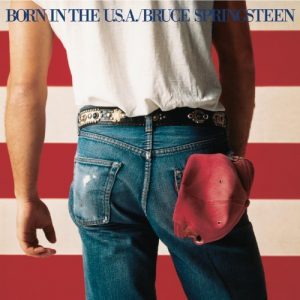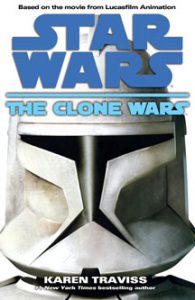Having just read Karen Traviss’ first four “Republic Commando” novels, it’s abundantly clear that she’s handcuffed on “The Clone Wars” movie novelization (2008). She tries to do what Matthew Stover did for “Revenge of the Sith” three years earlier and get into the characters’ heads more, putting more meat on the bones of the story, but this project isn’t set up for that: As essentially the first episode of a TV series, she can’t set up ongoing threads as she did with “Republic Commando,” because she doesn’t know where the TV writers will take things.
Still, it seems that Lucasfilm did commission this novelization for the sake of extra insight. The movie’s writers – Henry Gilroy, Scott Murphy and Steven Melching – aren’t credited at all on the book. On the other hand, Wookieepedia notes that “many details from the early drafts are present in the book.” As such, one can only guess which elements are Traviss’ and which are from the Gilroy, Murphy and Melching drafts.
The book’s most surprising additional element is the description of Ahsoka Tano, who is introduced as Anakin’s Padawan. We learn that Togrutas like to eat rodents, although Ahsoka tells Anakin that’s a stereotype – she personally doesn’t eat rodents. However, she does growl like an animal a few times. My guess is that Ahsoka’s primitive traits were in the early drafts, but voice actress Ashley Eckstein made the character her own – a 14-year-old girl who happens to be a Togruta, but could just as easily be a human. Indeed, when the Season 5 episode “The Gathering” shows us more Togrutas, they don’t possess particularly animalistic traits. As such, the idea of Ahsoka as a rodent-eating animal can be placed alongside C-3PO as an oily used-car salesman (George Lucas’ original vision) as a path not taken.
When Captain Rex – who will become Anakin and Ahsoka’s most trusted clone trooper — analyzes the big picture of the war, I lean toward thinking this is Traviss’ contribution. By the time of her third “Republic Commando” novel, “True Colors,” her clones begin to wonder if the awful war strategy is being devised on purpose by those at the top of the power structure. And by the fourth book, “Order 66” – which is concurrent with “Revenge of the Sith” — they confirm it.
When Rex thinks about the bad battle tactics on Teth – when the troopers climb up a cliffside, making them easy pickings – I tend to think this is Traviss’ sly way of commenting on a battle scene that came about because it looks cool in a movie rather than because it makes tactical sense. On the other hand, that might be giving too little credit to “The Clone Wars’ “ writers, who went on to pen many great episodes.
But as for this series-launching story, it’s a mixed bag. We do get wonderful new characters like Ahsoka, Rex and Ziro the Hutt. The latter is more vibrant in the movie; Traviss was not privy to the Hutt’s effeminate nature, something Lucas would devise later in the process. But the former two have substantial presences in the book. They were invented for “The Clone Wars” to be breakout characters (and they were), and Traviss certainly got the memo on this point.

The structure feels discombobulated, though, because the story was originally written as four episodes. Impressed with the look of the animation, Lucas decided to release this arc as a theatrical movie. When watching a movie, our brains are wired for three acts, and in the “Star Wars” universe, we’re wired for three-location movies. Because of this, the middle portion on Teth (which would’ve been the second and third episodes) seems to take forever. Another problem is that we as viewers (and readers) feel no connection to Christophsis or Teth – random staging grounds in the Clone Wars – so we want to get back to Tatooine (Anakin’s home planet, and the “home planet” of “Star Wars”) for the final act, which then feels to short.
The plot’s tension comes from Jabba the Hutt’s gullibility, and despite playing up Jabba’s grief over his son being kidnapped and his suspicions of both the Republic and the Separatists, Traviss fails to make the tension feel less manufactured. In all portrayals of Jabba prior to this (from the “Han Solo Trilogy” to the “Jabba the Hutt” comics), the gangster had been shown to be smart and savvy. Here, Jabba mostly accepts Dooku’s hole-filled premise that the Jedi kidnapped Rotta and now the Separatists will try to get him back to win Jabba’s favor. Even after Ahsoka and Anakin return Rotta to his dad, clearly showing that Dooku is a liar, Jabba inexplicably still wants to kill the Jedi.
Also, the scheme by Dooku is a bit thin by his standards. It’s emblematic of something that fans had to accept going forward: “The Clone Wars” would feature less nuanced stories, aimed more at kids than the EU’s 2003-08 Clone Wars novels and comics had been. (A few years later, this strategy became overt when Disney took over and canceled both the EU and “The Clone Wars,” clearing a path to make strictly kid-focused “Star Wars” stories going forward.)
Traviss does her best to reconcile these conflicting marketing strategies, including having Dooku and Ventress reflect on the pivotal moments that caused them to break from the Jedi Order – Dooku as a Jedi warrior on Galidraan in “Jango Fett: Open Seasons” and Ventress as a youngster on Rattatak in the “Republic” comics. But ultimately it’s an impossible task; on every page of “The Clone Wars,” a reader feels like Traviss is doing the best she can on a canvas that’s much more limited than her “Republic Commando” series.

